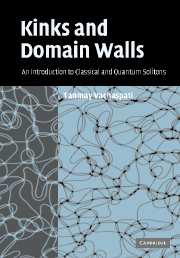Book contents
- Frontmatter
- Contents
- Preface
- 1 Classical kinks
- 2 Kinks in more complicated models
- 3 Interactions
- 4 Kinks in quantum field theory
- 5 Condensates and zero modes on kinks
- 6 Formation of kinks
- 7 Dynamics of domain walls
- 8 Gravity and cosmology of domain walls
- 9 Kinks in the laboratory
- Appendix A Units, numbers and conventions
- Appendix B SU(N) generators
- Appendix C Solution to a common differential equation
- Appendix D Useful operator identities
- Appendix E Variation of the determinant
- Appendix F Summary of cosmological equations
- References
- Index
5 - Condensates and zero modes on kinks
- Frontmatter
- Contents
- Preface
- 1 Classical kinks
- 2 Kinks in more complicated models
- 3 Interactions
- 4 Kinks in quantum field theory
- 5 Condensates and zero modes on kinks
- 6 Formation of kinks
- 7 Dynamics of domain walls
- 8 Gravity and cosmology of domain walls
- 9 Kinks in the laboratory
- Appendix A Units, numbers and conventions
- Appendix B SU(N) generators
- Appendix C Solution to a common differential equation
- Appendix D Useful operator identities
- Appendix E Variation of the determinant
- Appendix F Summary of cosmological equations
- References
- Index
Summary
In this chapter we study the effect of a kink on other bosonic or fermionic fields that may be present in the system. Under certain circumstances, it might be energetically favorable for a bosonic field, denoted by χ, to become non-trivial within the kink. Then we say that there is a “bosonic condensate” which is trapped on the kink. On a domain wall, the condensate has dynamics that are restricted to lie on the world-sheet of the wall.
The situation is similar for a fermionic field though there are subtleties. For a fermionic field, denoted by ψ, the Dirac equation is solved in the presence of a kink background made up of bosonic fields. This determines the various quantum modes that the fermionic excitations can occupy. In several cases, there can be “zero modes” of fermions in the background of a kink and this leads to several new considerations. (Fermionic zero modes were first discovered in [27, 84] in the context of strings.) In addition to the zero mode, there may be fermionic bound states. The high energy states that are not bound to the wall are called “scattering (or continuum) states.”
A difference between bosonic and fermionic condensates is that bosonic solutions can be treated classically but fermionic solutions can only be interpreted in quantum theory. For example, while there may be a bosonic solution with χ = 0, the solution ψ = 0 of the Dirac equation has no meaning because this solution is not normalizable. Solutions of the Dirac equation are only meant to supply us with the modes that fermionic particles or antiparticles can occupy, and as such are required to be normalizable.
- Type
- Chapter
- Information
- Kinks and Domain WallsAn Introduction to Classical and Quantum Solitons, pp. 73 - 89Publisher: Cambridge University PressPrint publication year: 2006



